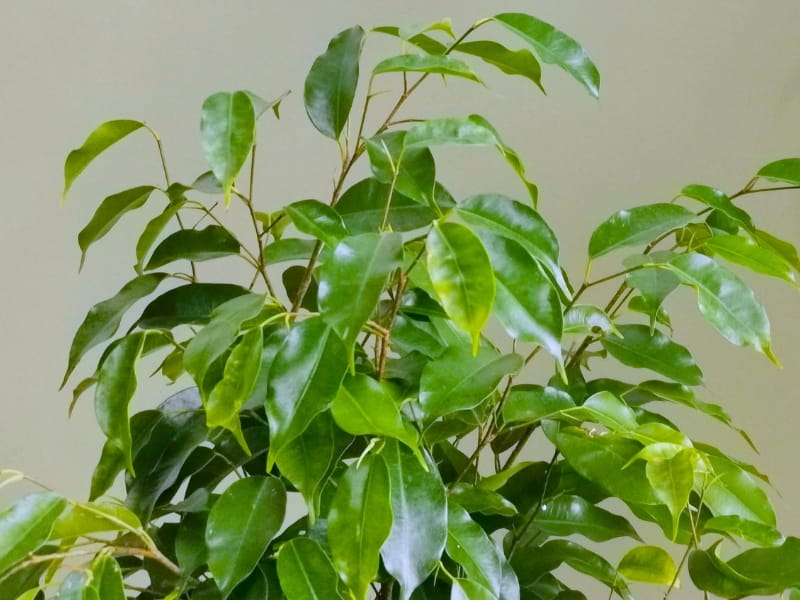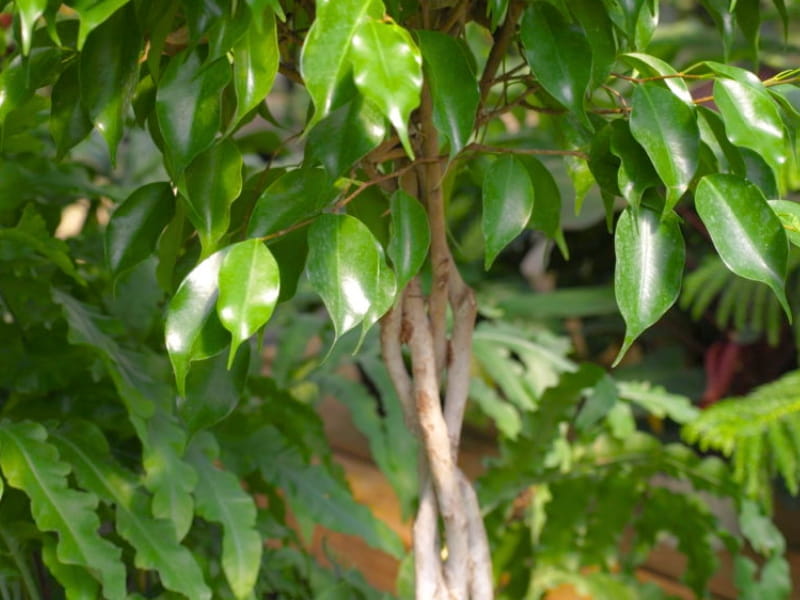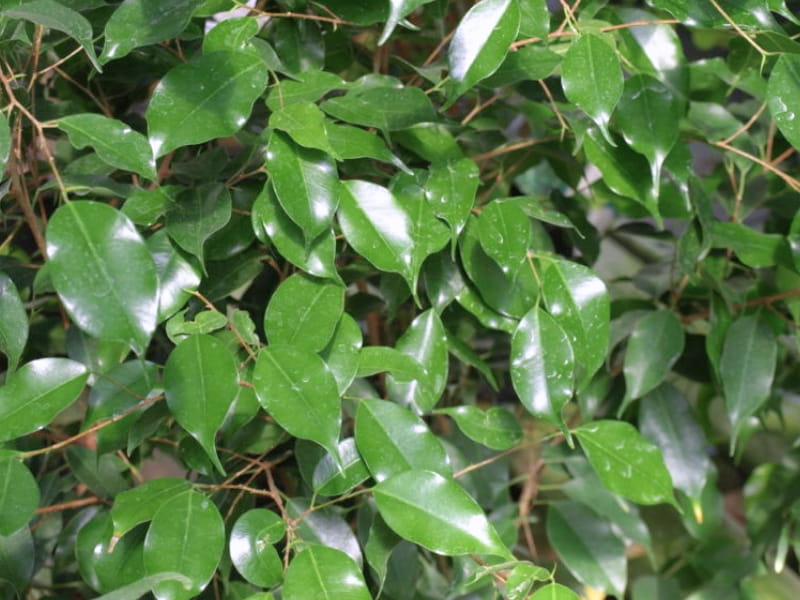Weeping Fig, also commonly known as the ficus tree, Benjamin fig, or Ficus benjamina, is a popular houseplant appreciated for its elegant, arching branches and glossy, green leaves. This tropical plant, related to the edible fig, can add a touch of natural beauty to any indoor space.
At Gardencenterpoint.com, we understand the challenges and rewards of caring for these sometimes-finicky plants. This guide provides complete Weeping Fig care solutions, helping you understand propagation, and address common problems. We offer a Ficus tree guide to suit every level.

1. Weeping Fig Overview: Understanding Your Ficus Benjamina
The Weeping Fig (Ficus benjamina) is a member of the Moraceae family, which also includes mulberries and breadfruit. Native to South and Southeast Asia and parts of Australia, it’s a tropical evergreen that can reach impressive heights of up to 60 feet in its natural habitat. As a houseplant, it’s typically kept much smaller, usually between 3 and 6 feet tall.
| Common Names | Weeping Fig, Benjamin Fig, Ficus Tree, Small-leaved Rubber Plant |
| Botanical Name | Ficus benjamina |
| Family | Moraceae (Mulberry or Fig Family) |
| Genus | Ficus |
| Species | benjamina |
| Origin | South and Southeast Asia, Australia |
| Native | Not native to the USA; widely cultivated as a houseplant |
| Life Cycle | Perennial (lives for more than two years) |
| Plant Type | Broadleaf Evergreen Tree (usually grown as a shrub or small tree indoors) |
| Hardiness Zones | 10-12 (USDA) – Generally grown as a houseplant in most climates |
| Sunlight | Bright, Indirect Light (avoid direct sunlight) |
| Maintenance | Moderate (requires consistent care, sensitive to changes) |
| Water | Moderate (allow top inch of soil to dry between waterings) |
| Drainage | Well-Drained (essential to prevent root rot) |
| Spacing | Varies depending on pot size and desired plant size; provide ample space for growth |
| Flowering Period | Rarely flowers indoors; inconspicuous flowers if they do occur |
| Height | Typically 3-6 feet indoors; can reach 60 feet in its native habitat |
| Growth Rate | Moderate (can be relatively fast-growing with optimal conditions) |
| Flower Color | Insignificant; greenish-white if they occur |
| Stem Color | Grayish-brown, becoming smoother with age |
| Foliage Color | Typically glossy, dark green; some cultivars have variegated leaves (e.g., white, cream, yellow) |
| Leaf Shape | Ovate, elliptical, with a pointed tip |
| Flower Benefit | Not applicable (flowering is rare indoors) |
| Garden Style | Tropical, Indoor, Container Gardening, Bonsai (some cultivars) |
| Uses | Houseplant, Ornamental, Air Purification, Office Plant, Specimen Plant |
| Toxicity | Mildly toxic to pets and humans (sap can cause irritation) |
| Air Purification | Excellent; removes formaldehyde, xylene, and toluene (according to NASA Clean Air Study) |
| Humidity Needs | Prefers high humidity; benefits from misting, pebble trays, or humidifiers |
| Temperature | Prefers warm temperatures (65-85°F / 18-29°C); avoid cold drafts |
| Soil pH | Slightly acidic to neutral (pH 6.0-7.0) |
| Propagation | Stem cuttings, Air Layering |
| Pests | Spider Mites, Mealy Bugs, Scale, Aphids |
| Diseases | Leaf Spot, Root Rot |
| Drought tolerance | Low |
| Deer Resistance | High |
The plant’s popularity stems from its graceful, weeping branches and abundant, small, glossy leaves. These leaves are typically 2-5 inches long and have a pointed tip. While Weeping Figs can produce small, inconspicuous flowers followed by fig-like fruits, this is rare in indoor environments.
Understanding the plant’s origins is key to providing proper care. Its tropical background means it thrives in warm, humid conditions with plenty of bright, indirect light. It’s also important to note that Weeping Figs are known for being somewhat sensitive to changes in their environment. Sudden shifts in light, temperature, or watering can lead to leaf drop, a common complaint among owners.
A study from the University of Georgia Extension highlights the importance of acclimating Weeping Figs gradually to new environments. They recommend placing a newly purchased plant in a location with similar light conditions to where it was previously grown and avoiding drastic changes in watering or temperature. This gradual transition helps the plant adjust and minimizes stress.
Furthermore, research published in the journal HortTechnology has shown that maintaining consistent soil moisture levels is crucial for Weeping Fig health. Overwatering or underwatering can both lead to leaf drop and other problems. The study emphasizes the importance of allowing the top inch of soil to dry out between waterings, but not letting the soil become completely dry.
The Weeping Fig’s sensitivity shouldn’t deter you, though. With the right care and attention, it can be a rewarding and long-lived addition to your home. The key is to provide consistent conditions and be observant of any changes in the plant’s appearance.
2. Ideal Growing Conditions for Weeping Figs
Creating the right environment is crucial for a thriving Weeping Fig. This section breaks down the essential elements: light, water, temperature, humidity, and soil.
- Light Requirements
Weeping Figs flourish in bright, indirect light. This means a location near a sunny window, but shielded from direct sunlight, which can scorch the leaves. An east-facing window is often ideal, providing gentle morning sun. South- or west-facing windows can also work, but you’ll likely need to use a sheer curtain or blinds to filter the intense afternoon light.
If you don’t have enough natural light, you can supplement with artificial grow lights. Full-spectrum LED grow lights are a good option, providing the necessary wavelengths for photosynthesis without generating excessive heat. Aim for 12-14 hours of light per day if using grow lights as the primary light source.
A study from the University of Florida IFAS Extension recommends using a light meter to measure the light intensity in your home. Weeping Figs generally need at least 100-200 foot-candles of light for optimal growth. Lower light levels can lead to leggy growth and leaf drop.
- Watering Best Practices
Proper watering is critical, and often a source of confusion for Weeping Fig owners. The key is to find a balance: not too wet, not too dry. The “finger test” is a reliable method. Stick your finger about an inch into the soil. If it feels dry, it’s time to water. If it feels moist, wait a few more days.
When you water, do so thoroughly, allowing water to drain freely from the bottom of the pot. This ensures that the entire root system is hydrated. Empty any excess water that collects in the saucer or tray beneath the pot to prevent root rot.
The frequency of watering will depend on several factors, including the size of the plant, the type of pot, the humidity level, and the time of year. During the active growing season (spring and summer), you’ll likely need to water more frequently than in the dormant season (fall and winter).
- Temperature and Humidity Needs
Weeping Figs prefer warm temperatures, ideally between 65°F and 85°F (18°C – 29°C). They are sensitive to cold drafts and sudden temperature fluctuations, so avoid placing them near doors, windows, or air conditioning vents.
Humidity is another important factor. Weeping Figs thrive in humid environments, similar to their tropical origins. Average household humidity is often too low, especially during the winter months when heating systems dry out the air.
Here are several ways to increase humidity around your Weeping Fig:
Pebble Tray: Place the pot on a tray filled with pebbles and water. As the water evaporates, it will increase the humidity around the plant. Make sure the pot is sitting on the pebbles, not in the water, to prevent root rot.
Humidifier: Use a room humidifier to add moisture to the air.
Grouping Plants: Grouping plants together can create a microclimate with higher humidity.
Misting: While misting can provide a temporary boost in humidity, it’s not as effective as the other methods and can sometimes encourage fungal diseases if the leaves stay wet for too long.
- Soil and Potting Mix Recommendations
A well-draining potting mix is essential for Weeping Figs. A good mix should retain some moisture but also allow excess water to drain freely, preventing root rot.
Here’s a recommended potting mix recipe:
- 1 part peat moss (or coco coir, a more sustainable alternative)
- 1 part perlite (for drainage)
- 1 part pine bark fines (for aeration and drainage)
You can also use a commercially available potting mix formulated for indoor plants, but make sure it’s well-draining. Avoid using heavy garden soil, which can compact and restrict drainage.
The pot you choose should also have drainage holes. Terra cotta pots are a good option because they are porous and allow for better air circulation around the roots. However, they also dry out more quickly than plastic pots, so you may need to water more frequently.

3. Weeping Fig Propagation: Creating New Plants
Propagating Weeping Figs is a rewarding way to expand your collection or share this beautiful plant with friends. The most common method is stem cuttings, but air layering is also an option.
- Step-by-Step Guide to Stem Cuttings
- Timing: The best time to take stem cuttings is in the spring or early summer, during the active growing season.
- Select a Stem: Choose a healthy, non-flowering stem that is about 4-6 inches long. It should have at least 2-3 leaves.
- Make the Cut: Use a clean, sharp knife or pruning shears to make a cut just below a node (the point where a leaf or branch grows from the stem).
- Remove Lower Leaves: Remove the leaves from the bottom 1-2 inches of the cutting to prevent them from rotting in the water or potting mix.
- Rooting Hormone (Optional): Dip the cut end of the stem in rooting hormone powder. This can help stimulate root growth, but it’s not essential.
- Planting: You can root the cutting in either water or a potting mix.
- Water: Place the cutting in a glass of water, making sure that the nodes are submerged. Change the water every few days to prevent bacterial growth. Roots should start to appear within a few weeks.
- Potting Mix: Plant the cutting in a small pot filled with a well-draining potting mix (see recipe above). Keep the soil moist but not soggy.
- Humidity: Cover the cutting with a plastic bag or humidity dome to create a humid environment. This helps prevent the cutting from drying out. Place it in a warm location with bright, indirect light.
- Transplanting: Once the cutting has developed a good root system (several inches long), you can transplant it into a larger pot with fresh potting mix.
- Air Layering: A More Advanced Technique
Air layering is a more advanced propagation method that involves rooting a stem while it’s still attached to the parent plant. It’s a good option for larger stems that are difficult to root as cuttings.
1. Select a Stem: Choose a healthy stem that is at least pencil-thick.
2. Make a Wound: Use a clean, sharp knife to make an upward-slanting cut about halfway through the stem, just below a node.
3. Apply Rooting Hormone: Apply rooting hormone powder to the wound.
4. Wrap with Moss: Wrap the wounded area with moist sphagnum moss.
5. Secure with Plastic: Wrap the moss with plastic wrap and secure it tightly with tape or twist ties. This creates a humid environment around the wound.
6. Monitor for Roots: Check the moss periodically to see if roots are forming. This can take several weeks or even months.
7. Separate and Plant: Once a good root system has developed, carefully cut the stem below the new roots and plant it in a pot with fresh potting mix.
4. Repotting Your Weeping Fig: When and How
Repotting is necessary as your Weeping Fig grows and its roots fill the current pot. It’s best to repot in the spring, before the active growing season begins.
Signs Your Weeping Fig Needs Repotting:
- Roots are growing out of the drainage holes.
- The plant is becoming root-bound (the roots are circling tightly around the inside of the pot).
- The soil dries out very quickly after watering.
- The plant’s growth has slowed down significantly.
Repotting Steps:
- Choose a New Pot: Select a pot that is only 1-2 inches larger in diameter than the current pot. A pot that is too large can lead to overwatering. Make sure the new pot has drainage holes.
- Prepare the New Pot: Add a layer of fresh potting mix to the bottom of the new pot.
- Remove the Plant: Gently loosen the plant from its current pot. You may need to tap the sides of the pot or run a knife around the inside edge to help release it.
- Inspect the Roots: Examine the roots for any signs of damage or disease. Trim away any dead or circling roots with clean, sharp pruning shears.
- Plant in the New Pot: Place the plant in the center of the new pot and add fresh potting mix around the roots, filling the pot to about an inch below the rim.
- Water Thoroughly: Water the plant thoroughly after repotting, allowing excess water to drain.
- Avoid fertilizing for about a month.
5. Fertilizing Your Weeping Fig for Optimal Growth
Fertilizing provides essential nutrients for healthy growth and lush foliage. During the active growing season (spring and summer), fertilize your Weeping Fig every 2-4 weeks. In the fall and winter, reduce fertilization to once every 6-8 weeks or even less.
Recommended Fertilizer:
- Use a balanced, water-soluble fertilizer formulated for indoor plants. A fertilizer with an N-P-K ratio of 10-10-10 or 20-20-20 is a good choice.
- Dilute the fertilizer to half the strength recommended on the package. Over-fertilizing can burn the roots and damage the plant.
Application:
- Water the plant thoroughly before fertilizing. This helps prevent fertilizer burn.
- Apply the diluted fertilizer solution to the soil, avoiding contact with the leaves.
- Follow the instructions on the fertilizer package for specific application rates.
6. Pruning Your Weeping Fig: Shape and Size Control
Pruning helps maintain the desired shape and size of your Weeping Fig and encourages bushier growth. The best time to prune is in the spring, before new growth begins.
Pruning Tools:
- Use clean, sharp pruning shears or bypass pruners.
- Sterilize your tools with rubbing alcohol or a bleach solution (1 part bleach to 9 parts water) before and after pruning to prevent the spread of disease.
Pruning Techniques:
- Thinning: Remove entire branches to open up the canopy and improve air circulation. Cut branches back to the point where they join a larger branch or the main trunk.
- Heading Back: Cut back the tips of branches to encourage bushier growth. Make cuts just above a node (the point where a leaf or branch grows from the stem).
- Removing Dead or Damaged Branches: Remove any dead, damaged, or diseased branches as soon as you notice them.
- Shape Control: Prune to maintain the desired shape and size of the plant. You can selectively remove branches to create a more open or compact form.
Important Note: Weeping Figs can exude a milky sap when pruned, which can irritate the skin. Wear gloves when pruning and wash your hands thoroughly afterward.
7. Common Weeping Fig Problems, Diseases and Solutions
Weeping figs, while generally resilient, are not immune to problems. This section acts as a troubleshooting guide, addressing common issues, diseases, and offering practical solutions. Gardencenterpoint understands that encountering problems with your plants can be frustrating, so we aim to provide clear, actionable advice.
7.1 Leaf Drop: The Most Common Complaint
Leaf drop is arguably the most frequent issue weeping fig owners face. It’s important to understand that some leaf drop is normal, especially after a change in environment. However, excessive leaf shedding signals stress. Let’s analyze the potential causes:
- Change in Environment/Repotting: Weeping figs are notoriously sensitive to changes. Moving the plant to a new location, even within the same room, can trigger leaf drop. Similarly, repotting, while necessary, can cause temporary stress.
- Solution: Minimize environmental changes whenever possible. If repotting is necessary, do so carefully, disturbing the roots as little as possible. Provide consistent care after the move or repotting, and the plant should recover. Expect some leaf loss, but it should stabilize within a few weeks.
- Underwatering: While they don’t like soggy soil, weeping figs need consistent moisture. Allowing the soil to dry out completely stresses the plant.
- Solution: Water thoroughly when the top inch of soil feels dry. Use a well-draining potting mix. A study from the University of Florida Extension recommends checking soil moisture regularly and adjusting watering frequency based on environmental conditions.
- Overwatering: Ironically, overwatering can also lead to leaf drop. Soggy soil suffocates the roots, preventing them from absorbing water and nutrients.
- Solution: Ensure the pot has drainage holes. Allow the top inch of soil to dry before watering again. Avoid letting the plant sit in standing water. Yellowing leaves before they drop often indicate overwatering.
- Low Humidity: Weeping figs thrive in humid environments, similar to their native tropical habitats. Dry air, especially during winter months when heating systems are running, can cause leaf drop.
- Solution: Increase humidity levels. You can group plants together, use a pebble tray filled with water, or use a humidifier. The American Horticultural Society recommends maintaining humidity levels between 40-50% for optimal plant health.
- Insufficient Light: While they tolerate low light, weeping figs need adequate bright, indirect light to thrive. Insufficient light weakens the plant, making it more susceptible to leaf drop.
- Solution: Place the plant near a window with bright, indirect light. Avoid direct sunlight, which can scorch the leaves. If natural light is limited, consider using a grow light.
- Temperature Fluctuations/Drafts: Sudden temperature changes or cold drafts can stress the plant.
- Solution: Avoid placing the plant near doors, windows, or air conditioning vents that may cause drafts. Maintain a consistent temperature, ideally between 65°F and 85°F (18°C and 29°C).
- Pest Infestations: See section 7.3 below.
- Nutrient Deficiencies: See section 7.4 below.

7.2 Root Rot: A Serious Threat
Root rot is a fungal disease that occurs when the roots are constantly exposed to excessive moisture. It’s a serious condition that can quickly kill a weeping fig if left untreated.
- Symptoms: Yellowing leaves (often starting at the bottom of the plant), wilting, stunted growth, and a foul odor from the soil. The roots themselves will appear brown and mushy instead of firm and white.
- Causes: Overwatering, poor drainage, and contaminated potting mix.
- Solutions:
- Prevention is key: Use a well-draining potting mix, water only when the top inch of soil is dry, and ensure the pot has drainage holes.
- If root rot is suspected: Gently remove the plant from the pot and inspect the roots. Trim away any brown, mushy roots with sterile scissors. Repot the plant in fresh, well-draining potting mix. Consider using a fungicide labeled for root rot, following the manufacturer’s instructions carefully. However, success is not guaranteed if the rot is advanced.
7.3 Pest Infestations: Identifying and Eliminating Common Pests
Weeping figs can be susceptible to several common houseplant pests. Early detection and treatment are crucial to prevent widespread infestation.
- Mealybugs: These appear as small, white, cottony masses on the stems and undersides of leaves. They suck sap from the plant, weakening it.
- Solution: Isolate the infested plant. For small infestations, dab the mealybugs with a cotton swab dipped in rubbing alcohol. For larger infestations, use insecticidal soap or neem oil, following the product instructions.
- Scale: These insects appear as small, brown bumps on the stems and leaves. They also feed on plant sap.
- Solution: Similar to mealybugs, small infestations can be treated with rubbing alcohol. For larger infestations, insecticidal soap or neem oil are effective.
- Spider Mites: These tiny pests are difficult to see with the naked eye. They create fine webbing on the plant and cause stippling or yellowing of the leaves.
- Solution: Increase humidity, as spider mites thrive in dry conditions. Rinse the plant with a strong stream of water to dislodge the mites. Insecticidal soap or neem oil can also be used.
- Aphids: These small, soft-bodied insects come in various colors (green, black, brown) and cluster on new growth. They suck sap and can distort leaves.
- Solution: A strong stream of water can dislodge aphids. Insecticidal soap or neem oil are also effective treatments.
The University of California Integrated Pest Management Program (UC IPM) offers extensive resources on identifying and managing houseplant pests using environmentally sound methods. Gardencenterpoint encourages reviewing their guidelines for detailed information.
7.4 Nutrient Deficiencies: Recognizing and Correcting Imbalances
Weeping figs, like all plants, require essential nutrients for healthy growth. Deficiencies can manifest in various ways.
- Nitrogen Deficiency: Older leaves turn pale green or yellow, starting at the tips. Growth may be slow.
- Phosphorus Deficiency: Leaves may appear darker green than usual, sometimes with a reddish or purplish tint.
- Potassium Deficiency: Older leaves may develop yellowing along the edges (marginal chlorosis) or brown spots.
- Magnesium Deficiency: Older leaves develop interveinal chlorosis (yellowing between the veins).
- Solutions:
- Use a balanced, water-soluble fertilizer formulated for houseplants. Apply during the growing season (spring and summer) according to the manufacturer’s instructions. Reduce or eliminate fertilization during the fall and winter.
- A soil test can help determine specific nutrient deficiencies. Many university extension services offer soil testing.
- Ensure the soil pH is appropriate for nutrient uptake. Weeping figs prefer slightly acidic to neutral soil (pH 6.0-7.0).
7.5 Fungal Leaf Spot Diseases:
These diseases appear as brown or black spots on the leaves, sometimes with a yellow halo. They are often caused by high humidity and poor air circulation.
- Solutions:
- Improve air circulation around the plant.
- Avoid wetting the foliage when watering.
- Remove and dispose of affected leaves.
- In severe cases, a fungicide labeled for leaf spot diseases may be necessary. Follow the manufacturer’s instructions.
7.6 Bacterial Leaf Spot:
Similar in appearance to fungal leaf spot, but often with a more water-soaked appearance.
- Solutions:
- The treatments are largely the same as Fungal Leaf Spot, with one important note. Copper-based fungicides are more effective on bacterial infections. Follow the manufacturer’s instructions.
8. Weeping Fig Varieties: Exploring Different Cultivars
While Ficus benjamina is the most common species, there are several cultivars with variations in leaf color, size, and growth habit. Here are a few popular examples:
- ‘Starlight’: This cultivar has variegated leaves with creamy white edges.
- ‘Golden King’: This cultivar has leaves with golden-yellow margins.
- ‘Too Little’: A compact cultivar that grows to only about 2-3 feet tall. It is great as a bonsai specimen.
- ‘Midnight’: This cultivar has very dark green, almost black, leaves.
- ‘Danielle’: This is a compact, disease resistance variety.
9. Weeping Fig Toxicity: Is It Safe for Pets and Children?
Weeping Figs are considered mildly toxic to pets (cats and dogs) and humans. The milky sap can cause skin irritation and, if ingested, can cause gastrointestinal upset, including vomiting and diarrhea.
Precautions:
- Keep Out of Reach: Keep Weeping Figs out of reach of pets and children.
- Wear Gloves: Wear gloves when pruning or handling the plant to avoid skin contact with the sap.
- Wash Hands: Wash your hands thoroughly after handling the plant.
- Contact Veterinarian or Doctor: If you suspect that your pet or child has ingested any part of a Weeping Fig, contact your veterinarian or doctor immediately. The ASPCA’s Animal Poison Control Center is also good resource.

Leave a Reply